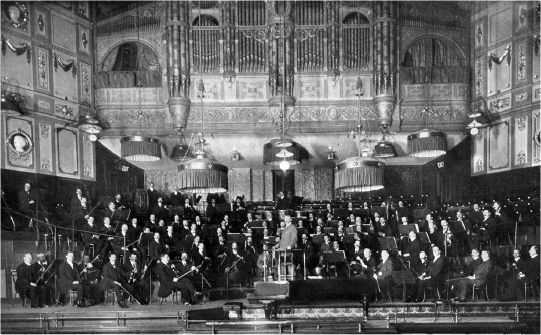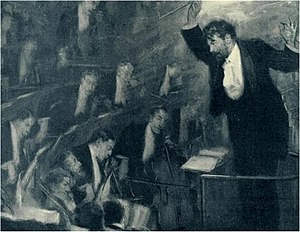Mahler 7 from Nott (Tudor)
This Mahler 7 from the Bamberg SO under Jonathan Nott is particularly interesting. His is not the first recording to feature antiphonal violins (Barenboim and Gergiev spring to mind - also excellent accounts) but I was gripped by the dangerously slow introduction. I don't think any of my previous favourite accounts (see below) have such a consistently slow introduction, without acceleration, and Nott manages to transition into the main Allegro section with us barely noticing the increase in tempo. The orchestral layout allows us to catch all sorts of details and dialogues between the violin sections.
The orchestra has a fine sound but, if anything, suffers from a lack of personality: the brass a little too well-rounded (some vibrato would be nice) and the woodwind I expected to sound a little more Bohemian. I don't think it rates as highly as Nott's Mahler 3, which was recently released, but it is an intriguing performance nevertheless and the return of the opening theme in the finale is really quite gripping.
My benchmarks:
London Symphony Orchestra/Michael Tilson Thomas (pure, unalloyed virtuosity, which has its place in this work and largely free of the idiosyncrasies that feature in his San Francisco cycle; often overlooked)
Berliner Philharmoniker/Claudio Abbado (probably the finest interpretation but prepare yourself for weird microphone-shifting sonics in that infamously tricky acoustic of the Philharmonie)
Schumann Piano Concerto from Oppitz (Tudor)
My next disc is one that easily attained benchmark status for me, and the antiphonal violins really were important for that, as is not always the case. Here, we have Gerhard Oppitz performing Schumann's wonderful Piano Concerto, along with other works for piano and orchestra, with the Bamberger Symphoniker under Marc Andreae.
This is at least as fine a performance as my previous benchmark (BPO/Andsnes/Jansons). The first thing that strikes you is that this is a first movement that is not hanging around! After the initial flourish, things really do get cracking but it never feels hurried, unlike the rather pallid recent account by Howard Shelley and the Orchestra of Opera North. Not only is the pianism fine in this performance but the orchestral contributions are special, too. Andreae clearly knows what he is doing with Schumann as every detail can be heard, without manipulation. Woodwind contributions, so important in this work, are beautifully shaped. Indeed, this recording allows the character of the wind players to shine through much more than the above one with the same orchestra.
Listen out for my favourite detail at 3:49 in the first movement! Those repeated concert Gs in the horns before the orchestral reprise in C major: so often undetectable on recordings (with the honourable exception of the Andsnes recording) and it is these little details that make such discs stand out.
The antiphonal violins come into their own throughout this recording but there are a couple of highlights for me. Firstly, the sinewy string passages in the tuttis of the first movement certainly benefit from this arrangement. However, it is an important moment in the final movement during which this arrangement really pays off. At around 9:20 into the movement the piece, in many recordings, can sound like Schumann ran out of inspiration but with this arrangement we can hear very clearly the answering phrases of the 2nd violins, which are the main voice in the musical argument. Finally, Oppitz then expertly paces the digression at 9:42 so that our interest never falters in this wonderful rondo movement.
A lovely bonus is a version of the Konzertstuck for Four Horns and Orchestra for piano and orchestra. It is no substitute for the real thing but allows the listener to hear all the lovely orchestral details clearly. It's also pretty good as a standalone fantasy for piano and orchestra in this form. The disc also, generously, includes the Introduction and Concert Allegro, Op 134 and the Introduction and Allegro appasionato, Op 92. What a great disc for Schumannophiles!
A lovely bonus is a version of the Konzertstuck for Four Horns and Orchestra for piano and orchestra. It is no substitute for the real thing but allows the listener to hear all the lovely orchestral details clearly. It's also pretty good as a standalone fantasy for piano and orchestra in this form. The disc also, generously, includes the Introduction and Concert Allegro, Op 134 and the Introduction and Allegro appasionato, Op 92. What a great disc for Schumannophiles!
My benchmarks:
This one!
Leif Ove Andsnes/Berliner Philharmoniker/Mariss Jansons (a lovely, if more spacious, account of this enduring masterpiece with that beefy Berlin sound)
The ultimate Symphonie Fantastique from Ticciati (Linn)
I was most surprised when I listened to this new release from the Scottish Chamber Orchestra under Robin Ticciati, the first in a promising series of Berlioz recordings. This up-and-coming fellow is a protege of Sir Colin Davis and so one might expect him to adhere closely to his mentor's approach. Nothing of the sort! That is, apart from sharing a wonderful and complete vision of the work.
This is essentially a period-influenced modern chamber orchestra version of the work: strings often use minimal vibrato (to the point of sounding like Norrington's Stuttgart players) and we hear natural horns, too. I suppose I find this most surprising as (see my previous post) Sir Colin has recently denounced historically-informed approaches and one wonders what he might think of this recording! That said, I think this approach (even with much smaller string forces than Berlioz would have expected or hoped for) works very well. There are several period instrument recordings of this work (Norrington, Gardiner and van Immerseel spring to mind) but I think SF benefits from the immediacy of sound that modern instruments bring. Here, the reduced strings means that all the details you might hope to hear are audible. I missed the luxury of addional strings here and there, particularly in the bassi departments, but this is a small point overall.
The benefits of antiphonal violins are plain even in the wonderfully shaped introduction. This is one of those works that is the easy answer to the question "why antiphonal violins?" and I am surprised that so few recordings feature this arrangement. It just adds to the edginess and wild originality that pervades the work. I have no idea why Rattle, in his recent Berlin recording, reverted to lumping the violins together when he does not most of the time. That SF was far too plush and comfortable as most of the modern symphony orchestra recordings are, sadly, which makes them doomed to fail. As it happens, Ticciati seats his cellos centre-right in this recording. with violas centre-left and eminently audible.
Ticciati paces the first movement perfectly so that the climax is a right old riot as it should be. He never loses a lucid sense of pacing either in these exciting moments throughout the piece, even in the coda of the finale. The second movement waltz is graceful and charming as the strings are permitted a little more vibrato here. Listen out for the all-important 1st/2nd violin dialogue in the frenzied close of this movement! The third movement has beautifully played oboe and cor anglais solos and one senses a great deal of concentration here from all the players. The 'thunder' on the timps sounds particularly chilling. The March to the Scaffold in the fourth movement is swifter than I expected but is exciting and the timp players, otherwise faultless, get their timing perfectly right only in the repeat of the exposition. For the record, all the repeats in this piece are observed, thankfully.
Ticciati paces the first movement perfectly so that the climax is a right old riot as it should be. He never loses a lucid sense of pacing either in these exciting moments throughout the piece, even in the coda of the finale. The second movement waltz is graceful and charming as the strings are permitted a little more vibrato here. Listen out for the all-important 1st/2nd violin dialogue in the frenzied close of this movement! The third movement has beautifully played oboe and cor anglais solos and one senses a great deal of concentration here from all the players. The 'thunder' on the timps sounds particularly chilling. The March to the Scaffold in the fourth movement is swifter than I expected but is exciting and the timp players, otherwise faultless, get their timing perfectly right only in the repeat of the exposition. For the record, all the repeats in this piece are observed, thankfully.
The finale is rightly vulgar - check out the rasping lower brass and shrieking clarinets! The coda, as mentioned above, gains pace only fractionally and the vital lower brass contributions can be heard throughout. As a bonus, there's a nice reading of the Beatrice et Benedict overture, too. Bravo!
My benchmarks:
This one!
South West German Radio Symphony Orchestra (Stuttgart)/Sir Roger Norrington (a full-size modern orchestra with period manners, employing not only antiphonal violins but harps, too!)
Concertgebouw Orchestra/Sir Colin Davis (a revelatory reading that is not to be missed in full-bodied orchestral sound but with the lucidity of texture that only this orchestra can muster so well; also features the additional ad lib cornet contributions that are absent in the urtext edition of the score. Davis's LSO Live remake is also fine but the Barbican acoustic renders the sound a bit too dry and chunky for my taste. Violins not antiphonal but the recording gives good separation nonetheless)
-----------------------
You might also like to know that all of these recordings are available on SACD, if you're into that. Please see www.SA-CD.net for reviews of these discs and many more. The website features reviews by folks a lot more experienced at reviewing than me. If you're into downloading, like me, then you might be interested to have a look at www.emusic.com, where recordings such as the above can be downloaded at ridiculously cheap prices much of the time, if you subscribe.





